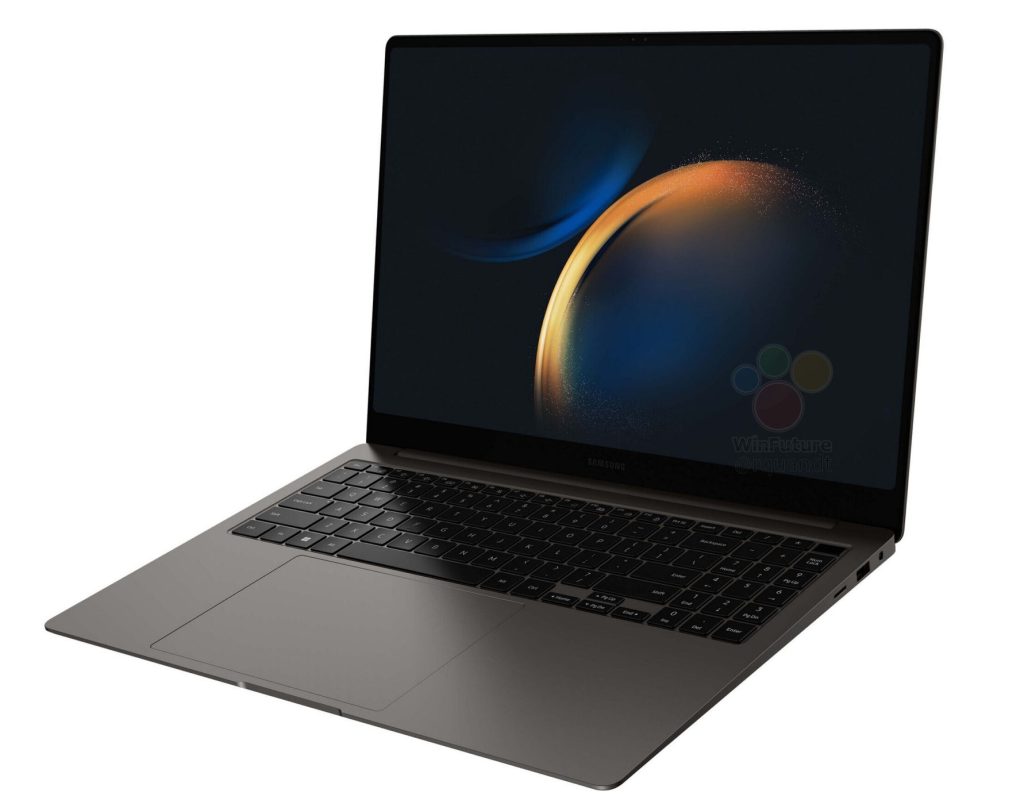Samsung’s Galaxy Book3 series is expected to be unveiled next week, along with the S23 series. Thanks to WinFuture, detailed specifications and the images of laptops have emerged online. The Galaxy Book3 series will include models such as the Galaxy Book3, Galaxy Book3 Pro, and Galaxy Book3 Ultra. There are also 2-in-1 models, the Galaxy Book3 360 and Galaxy Book3 Pro 360, both of which support the S-pen.
The laptops will all be outfitted with the most recent Intel 13th Gen Raptor Lake mobile processors, with the Ultra model including up to an Nvidia RTX 4070 GPU. These are expected to be revealed at the S23 Unpacked event on February 1.

Samsung Galaxy Book3 Ultra:
The Galaxy Book3 Ultra is the high-end model, with a 16-inch WQXGA+ AMOLED (2880 x 1800 pixels) display, a refresh rate of 120Hz, and a peak brightness of 500 nits. The 13th-generation H series processors with up to an i9-13900H configuration will power this. It will be come with up to 32GB of RAM and an Nvidia RTX 4070 GPU.
Samsung Galaxy Book3 Ultra Expected Specifications:
- 16″ WQXGA+ (2880 x 1800 pixels) AMOLED screen, 16:10, 120Hz, 500 nits peak brightness
- Intel Core i7-13700H or Intel Core i9-13900H CPU
- Nvidia RTX 4050 or Nvidia RTX 4070 GPU
- 16GB/32GB LPDDR5 RAM, 512GB/1TB Gen 4 M.2 PCIe NVMe SSD
- Windows 11 Home
- 2x Thunderbolt 4, 1x USB A 3.2 Gen 1, 2x USB-C 3.2 Gen 2, HDMI, MicroSDXC, 3,5mm headphone jack
- FullHD webcam
- AKG quad speakers, Dolby Atmos support
- WiFi 6, Bluetooth 5.1
- Dimensions: 1.65 x 35.5 x 25 cm Weight: 1.79Kg
- 76Wh battery, up to 17.5 hours run time
Samsung Galaxy Book3 and Galaxy Book3 360:
The Galaxy Book3 is the entry-level model in the series, which will have a 15.6-inch FullHD IPS LCD screen with up to 300 nits of peak brightness. These will be equipped with 13th-generation Intel Core U series processors, up to the Core i7-1355U version. This does not include a dedicated graphic card and relies on integrated Iris XE graphics.
The 2-in-1 version of the Galaxy Book3, on the other hand, should come in two screen size options: 13.3 inches and 15.6 inches. The screen is an OLED one with FullHD resolution and touch and S-pen support. This will contain 13th-generation Intel Core P series processors with an Iris Xe GPU.
Samsung Galaxy Book3 and Galaxy Book3 360 Expected Specifications:
- Galaxy Book3: 15.6″ FullHD (1920 x 1080 pixels) IPS LCD screen, 16:9, 60Hz, 300 nits peak brightness
- Galaxy Book3 360: 13.3″/15.6″ FullHD (1920 x 1080 pixels) OLED screen, 16:9, 120Hz, HDR 500, 370 nits peak brightness
- Galaxy Book3: Intel Core i3-1315U or Intel Core i5-1335U or Intel Core i7-1355U CPU
- Galaxy Book3 360: Intel Core i5-1340P or Intel Core i7-1360P CPU
- Intel Iris Xe graphics
- 8GB/16GB LPDDR4X RAM, 256GB/512GB Gen 4 M.2 PCIe NVMe SSD
- Windows 11 Home
- 1x Thunderbolt 4, 1x USB A 3.2 Gen 1, 1x USB-C 3.2 Gen 2, HDMI, MicroSDXC, 3,5mm headphone jack
- FullHD webcam
- Dual speakers, Dolby Atmos support
- WiFi 6, Bluetooth 5.1
- Galaxy Book3 – Dimensions: 1.54 x 35.6 x 22.9 cm Weight: 2.44Kg
- Galaxy Book3 360 – Dimensions: 1.29 x 30.4 x 20.2 cm (13.3″), Weight: 1.83Kg(13.3″); Dimensions: 1.37 x 35.5 x 22.8 cm (15.6″), Weight: 1.24Kg(15.6″)
- Galaxy Book3: 54Wh battery
- Galaxy Book3 360: 61.1Wh (13.3″), 68Wh (15.6″)
Samsung Galaxy Book3 Pro and Galaxy Book3 Pro 360:
The Galaxy Book3 Pro is expected to have a 14- or 16-inch WQXGA+ (2880×1800 pixel) OLED display with a refresh rate of 120Hz and a peak brightness of 400 nits. These will be equipped with 13th-generation Intel Core P series processors, up to and including the Core i7-1360P.
The Galaxy Book 3 Pro 360 is essentially a 2-in-1 variant of the 16-inch model with a folding display and touchscreen that supports the S Pen.
The device is nearly identical except for the stylus and touchscreen.
Samsung Galaxy Book3 Pro and Galaxy Book3 Pro 360 Expected Specifications:
- Galaxy Book3 Pro: 14″/16″ WQXGA+ (2880×1800 pixel) OLED screen, 16:10, 120Hz, HDR 500, 400 nits peak brightness
- Galaxy Book3 Pro 360: 16″ WQXGA+ (2880×1800 pixel) OLED screen, 16:10, 120Hz, HDR 500, 400 nits peak brightness
- Intel Core i5-1340P or Intel Core i7-1360P CPU
- Intel Iris Xe graphics
- 16GB LPDDR5 RAM, 512GB Gen 4 M.2 PCIe NVMe SSD
- Windows 11 Home
- 2x Thunderbolt 4, 1x USB A 3.2 Gen 1, 2x USB-C 3.2 Gen 2, HDMI, MicroSDXC, 3,5mm headphone jack
- FullHD webcam
- AKG quad speakers, Dolby Atmos support
- WiFi 6, Bluetooth 5.1
- Galaxy Book3 Pro – Weight: 1.17Kg (14″), 1.56Kg (16″)
- Galaxy Book3 Pro 360 – Weight: 1.8Kg (16″)
- 63Wh (14″), 76Wh (16″)
Expected Pricing:
The Galaxy Book3 Ultra is expected to start at 2900 euros (US$ / Rs. 2,57,020 approx.) for the i7 variant while the i9 variant should cost around 3800 euros (US$ 4,131 / Rs. 3,36,785 approx.). The pricing of the 14″ model of Galaxy Book3 Pro is expected to start at 1749 euros (US$ 1,901 / Rs. 1,55,009 approx.) while 16″ versions are said to around 1949 euros (US$ 2,119 / Rs. 1,72,735 approx.).
The expected prices of the entry level Galaxy Book3 models are unknown. We should know the official prices and some more details after the launch on February 1, 2023.